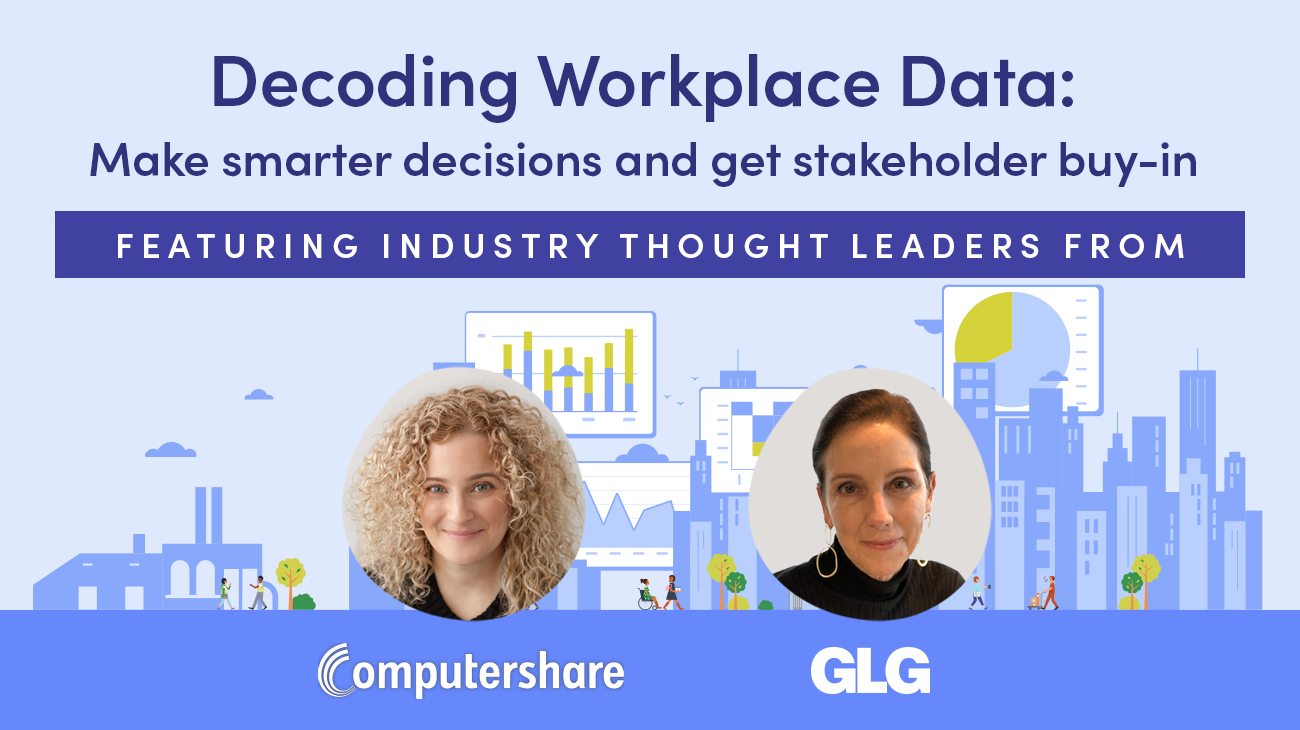The way we use our workplaces has changed drastically over the past few years. With more flexibility and variability in how and when we use these spaces, accurate data is the key to making more informed decisions about our workplaces.
In our webinar, "Decoding workplace data: Make smarter decisions and get stakeholder buy-in," we hosted a panel discussion on this very topic with two workplace management experts:
- Ronda Stahl, GLG’s director of facilities and real estate
- Jenna McLean, Computershare’s global workplace occupancy analyst
Let's look at some of the key insights provided by our webinar panelists.
Meet the experts

Ronda Stahl: “I’m the director of facilities and real estate for GLG. We have global offices in 21 different locations and around 2,800 employees. My department helps navigate the different ways we look at real estate, and how we utilize our office space in this post-pandemic world.”
Jenna McLean: “I'm a global workplace occupancy analyst with Computershare. I look at how we're globally using our real estate, ways to use it more effectively, and create a cohesive plan for our overall portfolio. Computershare has 80+ offices in 22 countries, and we have about 14,000-15,000 employees.
How these two companies view onsite work + spontaneous collaboration
Our recent study found that 96% of companies are now back onsite in some capacity, and GLG and Computershare are two prime examples of hybrid office models in action. Here’s how they make it work:
Jenna: “Currently, our policy mandates a two-day office presence per week, although this can extend to five days for certain roles. One major challenge we face is ensuring regular office attendance. We're exploring various strategies to foster onsite engagement, such as forming a social committee, organizing town halls, and featuring executive speakers on Zoom. Additionally, we're actively promoting the benefits of physical presence in the office, such as increased face time with leadership and enhanced growth opportunities.
This approach is particularly crucial because many team members were hired during the pandemic and haven't had a chance to forge strong connections with their colleagues. We emphasize the value of in-person interactions for building relationships and uncovering opportunities that might go unnoticed in a remote setting. We’ve equipped our office with appealing amenities to make the workplace inviting and encourage daily attendance.”
Ronda: “We may not mandate the number of days, or which days are in the office, but there is an inclination for two days a week, sometimes three or more for some people. The thought process is to get people into the office not only to learn from their coworkers, especially if they were hired during the pandemic, but also have those who are more experienced be able to share their knowledge.
There's a lot of value in that, and another benefit is being able to just look across the desk and ask a colleague something that came up or just even share what maybe you watched last week. Those are the relationship building things that happen in person. That's what encourages people to spend more time coming to the office.”
The types of workplace data that guide real estate and resource investments
Navigating workplace occupancy and space utilization data is a newer challenge for many companies, especially those implementing hybrid work for the first time. Watch the webinar to learn about the types of data our panelists look at and how that data influences decision-making and resource planning.

Real-life examples of occupancy data in action
Next. we asked our panelists to share specific examples of the ways data informs their workplace decisions. Here’s one example from the webinar that shows how data can help you create optimal work environments for your employees.
Jenna: We just reopened a new office in Louisville and went from around eight floors to two floors in a new space. So this data really does drive our decisions. Facilities management at Computershare used to be kind of a siloed division, but now we're really working as a partner because real estate is one of the biggest spends. Most leases, typically pre-pandemic, are a minimum of 10 years, and now we're looking at three to five-year leases. It’s important for us to understand the business side, where they see things going, and the type of space they want. Then, we take all the occupancy data we have and map it into their actual requirements.
We also think about how we can make this space better for everyone. What we’ve found is that with a hybrid model, people are more willing to come in, and we have more money to invest in them. We're using our money more wisely. It's really to put our focus on what is valuable to an employee. Is it in-office amenities? Is it being closer to transit? That's what’s driving absolutely every one of our decisions. We don't look at a new space or lease unless we have complete data on how that space is being used, who it’s being used by, and what their commutes are like. It affects everything we do nowadays.
Watch the full webinar
Want to see the full range of topics covered in this webinar? You can watch it on demand here.
If you’re ready to dive deeper into the occupancy analytics, take a look at our Ultimate guide for proactive space management.
Read more
Searching for a visitor management solution? Learn what to look out for and how to choose the best tech for your team.
Managing your space well doesn’t have to be difficult. But if you want to be successful, you need the right approach.
A well-run workplace can set your team up for success. Learn why workplace management matters and how to do it right.
Workplace security is critical to the future of your business. Learn why it matters, what threats to watch for, and how to strengthen your workplace security plan.
In this post, we’ll explore what workplace compliance is and how to build a compliance culture for your organization.
With more folks sending personal packages to the workplace, having a sound mailroom management system in place is key.










